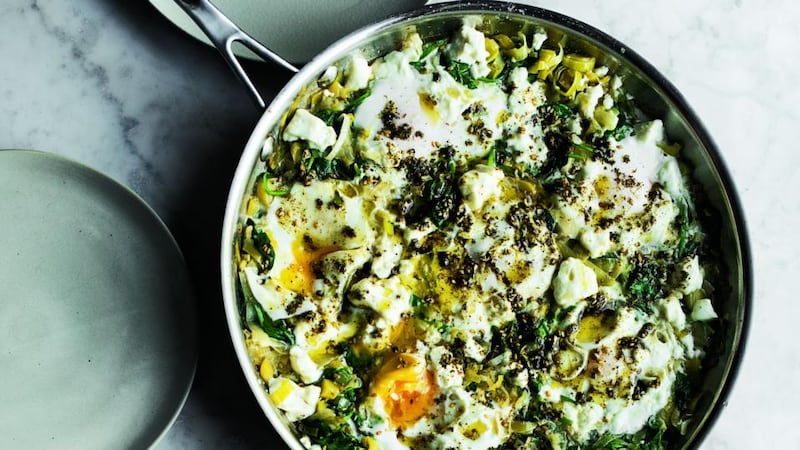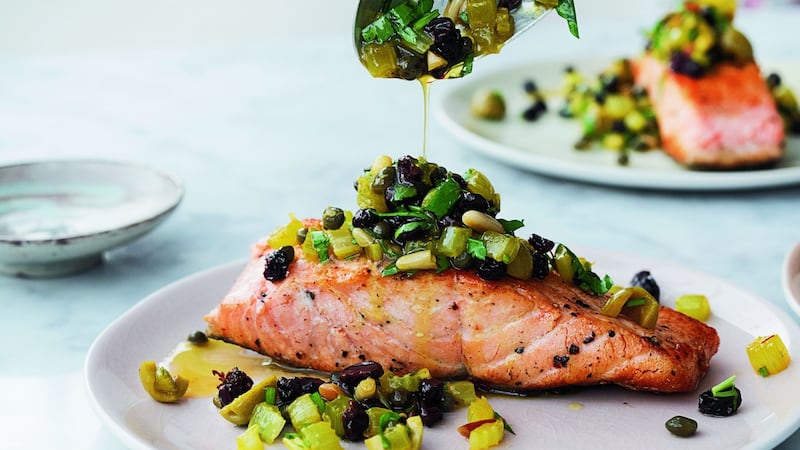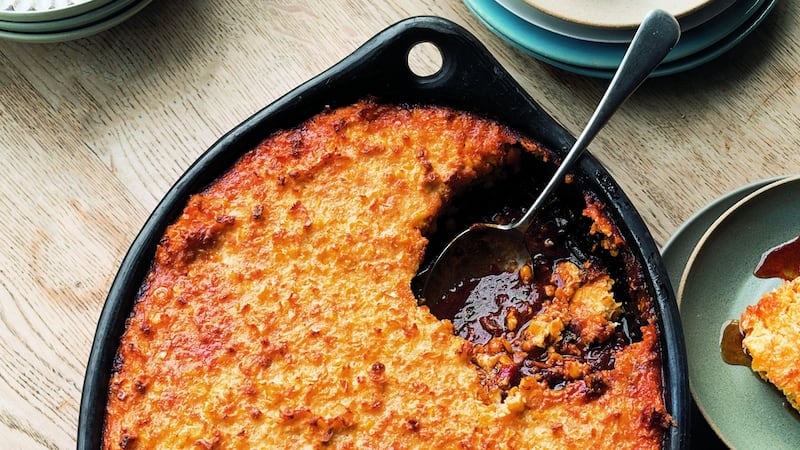“My sister Tirza is a busy working woman and she has said to me, often, in the best possible way, ‘I’ll never cook your food, because I don’t have time for it’. And then when I told her about this book, she said ‘Finally, I’ll be able to cook your food’.”
The anecdote is delivered with a smile, and it is clear that Yotam Ottolenghi, restaurateur and food writer, has heard all the gags about the special shopping expeditions and the many-step methods his recipes are known for. He turns the joke back on himself when talking about his latest book, Ottolenghi Simple, a collection of recipes that adhere to his new mantra – "minimum hassle, maximum joy".
“I know, I know. I’ve seen the raised eyebrows, I’ve heard the jokes. The one about the reader who thought there was part of a recipe missing as they already had all the ingredients they needed in their cupboard. Or the one about ‘Just popping out to the local shop to buy the papers, milk, black garlic and sumac’.”

It is a reputation he thinks is unwarranted where his seven titles are concerned. "I actually think if you check the books one by one, except NOPI, which is a restaurant book, you'll find about 50 per cent of the recipes are actually pretty easy and simple to make. But this book is dedicated to just those things," he says, sipping tea at a counter table in ROVI, the latest addition to his and his partners' London restaurant empire. The newcomer is an 85-seater with a special focus on vegetables, cooked over fire, and on fermentation.
By making his recipes more accessible, Ottolenghi, who will celebrate his 50th birthday in December, wants to take stress and recrimination out of the kitchen. “I find it really quite disheartening, many of the attitudes that are being attached to food at the moment – you know, the business of being told what you should eat and how you should eat and how much you should cook and what you should cook. It is turning something which is very natural, taught in a family from one generation to the next, or just a fun experience, into one of modern life’s extra level of anxieties.”
Repetition, rather than innovation, should be the norm in everyday cooking, he believes. “I have some friends that cook one or two things really, really well and they carry on cooking those things and I feel very blessed when I come to their house and I know I’m going to get that great thing that they make.”
So is he telling us to relax around food, and be kinder to ourselves? “Yes, I think that sums it up nicely. I think it is something that makes sense at this point in history, when there’s just so much to worry about, and there’s such a sense of uncertainty and a lot of negativity around.”
At this stage I'm very happy to give up a little bit of the extra complications that I've added in the past and pare things back a bit
He says he worries about “where we’re all heading”, and global politics and social unrest. “There is a lot of racism, there is a lot of bigotry and it seems to be on the increase. So I worry about that and I worry about my children having to grow up in a world where I can’t tell them, actually things are getting better, because it seems like things are getting worse at the moment.”
On a more light-hearted note, he is looking forward to his book tour taking him back to Dublin this month. Scrolling through his mobile phone images, he tells me about a memorable meal he enjoyed in Etto last year. “It was so good – best meal of the year. I had mussels, and I think this was ox tongue, and this beautiful salad with black radishes, and then gnocchi or maybe gnudi. It had that light touch that I really love.”
Simplicity, and things done well, are features he admired in Etto, and they are also at the forefront of his latest restaurant. “We really focus on the ingredients, with less components, and much more the naked ingredients, so you’re a little bit more exposed here than the other restaurants. Everything needs to be perfect.”
You can see why simplicity would appeal to a busy father of two small boys, with a string of restaurants to run, a weekly newspaper column to write and a cookery book almost always on the go. “At this stage I’m very happy to give up a little bit of the extra complications that I’ve added in the past and pare things back a bit,” he says with a wry smile.
Cooking for kids
When we meet, the boys, Max (5) and Flynn (3), are holidaying in Northern Ireland, with Ottolenghi's husband, Karl Allen, who is from Co Down, and he has been back and forward from their Camden base. "I spent a good couple of weeks, so far, there this summer," he says, including a trip with his parents, who were visiting from Israel.
He has said that Simple is "the one book I cook with at home". So is he charged with feeding the family, as well as the public, and do the little ones chomp enthusiastically on aubergine and kale? "No, I do cook at home but I am not the cook at home. Karl cooks more often than I do. He's got more time to cook and he spends more time with the children. I think he's also more naturally suited to cooking for children because he doesn't overcomplicate things and kids have very simple palates."
Apart from raw tomatoes, which are a no-go, “they’re not really picky kids”, he says. “They are both typical little boys. They love their starches and so they will eat rice and pasta, but less of the vegetables. ”
Family life and domesticity are themes Ottolenghi will be exploring in his new podcast series, Simple Pleasures, which launched last week and in which he invites Michael Palin, Nadiya Hussain, Lin-Manuel Miranda, Jessie Ware, Nigella Lawson and Fearne Cotton to his home for a chat while he cooks for them.
SIMPLE acronym
The guests will eat dishes from the new book, which grew out of a series of easy, quick, seasonal recipe booklets Ottolenghi was commission to write for the Guardian in 2016. "When we first got the brief, my reaction was, Oh gosh, how do we do Ottolenghi simple?" he says. But, teasing the idea out with his writing and recipe-testing collaborators Tara Wigley and Esme Howarth, the challenge of delivering the customary Ottolenghi big flavours, but with less effort and fewer ingredients, began to look appealing.
The trio came up with the acronym SIMPLE – short on time: less than half an hour; ingredients: 10 or fewer; make ahead; pantry-led; lazy, and easier than you think, and developed a colour-coded index system that will help readers to identify the recipes in the book that best fit their requirements.
He ended up relishing the challenge of producing those pared-back recipes. "The Guardian loved it, the readers loved it, and we enjoyed doing it", and so the booklets grew into a book, with 130 new recipes, which is published this week.
BRAISED EGGS WITH LEEK AND ZA’ATAR: SERVES 6

Ingredients
30g unsalted butter
2tbs olive oil
2 large leeks (or 4 smaller), trimmed and cut into half cm slices (530g)
1tsp cumin seeds, toasted and lightly crushed
2 small preserved lemons, pips discarded, skin and flesh finely chopped (30g)
300ml vegetable stock
200g baby spinach leaves
6 large eggs
90g feta, broken into 2cm pieces
1tbs za'atar
Salt and black pepper
Method
This is a quick way to get a very comforting meal on the table in a wonderfully short amount of time. It's a dish as happily eaten for brunch, with coffee, as it is for a light supper with some crusty white bread and a glass of wine. The leeks and spinach can be made up to a day ahead and kept in the fridge, ready for the eggs to be cracked in and braised.
1 Put the butter and a tablespoon of oil in a large sauté pan, for which you have a lid, and place on a medium-high heat. Once the butter starts to foam, add the leeks, half a teaspoon of salt and plenty of pepper. Fry for three minutes, stirring frequently, until the leeks are soft. Add the cumin, lemon and vegetable stock and boil rapidly for four to five minutes, until most of the stock has evaporated. Fold in the spinach and cook for a minute, until wilted, then reduce the heat to medium.
2 Use a large spoon to make six indentations in the mixture and break one egg into each space. Sprinkle the eggs with a pinch of salt, dot the feta around the eggs, then cover the pan. Simmer for four to five minutes, until the egg whites are cooked but the yolks are still runny.
3 Mix the za'atar with the remaining tablespoon of oil and brush over the eggs. Serve at once, straight from the pan.
BRIDGET JONES’S PAN-FRIED SALMON WITH PINE NUT SALSA

This is the dish Patrick Dempsey's character tells Renée Zellweger's Bridget Jones that he would have brought her on their imaginary second date in Bridget Jones's Baby. "From Ottolenghi," says Dempsey, "delicious and healthy!" And easy, we might add! What sounded like a bit of product placement on our part was in fact no such thing. The recipe didn't even exist on our menu, so this is a retrospective acknowledgement.
Ingredients
Serves 4 (or half the recipe if you're on that second date!)
100g currants
4 salmon fillets, skin on and pin-boned (500g)
100ml olive oil
4 celery sticks, cut into 1cm dice (180g), leaves removed but kept for garnish
30g pine nuts, roughly chopped
40g capers, plus 2tbs of their brine
40g large green olives, pitted and cut into 1cm dice (about 8)
1 good pinch of saffron threads (¼tsp), mixed with 1tbs hot water
20g parsley, roughly chopped
1 lemon: finely grate the zest to get 1tsp, then juice to get 1tsp
Salt and black pepper
Method
1 Cover the currants with boiling water and set aside to soak for 20 minutes while you prep the salmon and make the salsa.
2 Mix the salmon with two teaspoons of oil, 1/3 teaspoon of salt and a good grind of pepper. Set aside while you make the salsa.
3 Put 75ml of olive oil into a large sauté pan and place on a high heat. Add the celery and pine nuts and fry for four to five minutes, stirring frequently, until the nuts begin to brown (don't take your eyes off them, as they can easily burn). Remove the pan from the heat and stir in the capers and their brine, the olives, saffron and its water and a pinch of salt. Drain the currants and add these, along with the parsley, lemon zest and lemon juice. Set aside.
4 Put the remaining tablespoon of oil into a large frying pan and place on a medium-high heat. Once hot, add the salmon fillets, skin-side down, and fry for three minutes, until the skin is crisp. Reduce the heat to medium, then flip the fillets over and continue to fry for two to four minutes (depending on how much you like the salmon cooked). Remove from the pan and set aside.
5 Arrange the salmon on four plates and spoon over the salsa. If you have any celery leaves reserved, scatter these on top.
SLOW-COOKED CHICKEN WITH A CRISP CORN CRUST: SERVES 6

Ingredients
3tbs olive oil
3 red onions, thinly sliced (500g)
2 garlic cloves, crushed
3tbs rose harissa
2tsp sweet smoked paprika
850g chicken thighs, skinless and boneless (about nine to 10 thighs)
200ml passata
5 large tomatoes, quartered (400g)
200g jarred roasted red peppers, drained and cut into 2cm-thick rounds
15g dark chocolate (70 per cent cocoa solids)
20g coriander, roughly chopped
Salt and black pepper
Sweetcorn batter
70g unsalted butter, melted
500g corn kernels, fresh or frozen and defrosted (shaved corn kernels from 4 large corn cobs, if starting from fresh)
3tbs whole milk
3 eggs, yolks and whites separated
Method
This is a wonderful meal on an autumn day, served with a crisp green salad. The slow-cooked chicken is packed full of flavour and the crust – gluten-free, rich and corny – makes for a welcome (and lighter) change to a heavier mash.
You can make the chicken well in advance if you want to get ahead: it keeps in the fridge for up to three days or can be frozen for a month. You want it to go into the oven defrosted, though, so it will need thawing out of the freezer.
The batter needs to be made fresh and spooned on top of the chicken just before the dish gets baked, but it then can just go back in the oven. It can also be baked a few hours in advance – just warm through for 10 minutes, covered in foil, before serving. I love the combination of the chicken and the corn, but the chicken also works well as it is, served on top of rice, in a wrap or with a buttery jacket potato.
1 Heat the oil in a large sauté pan, for which you have a lid, on a medium high heat. Add the onions and fry for 8-9 minutes, stirring a few times, until caramelised and soft. Reduce the heat to medium and add the garlic, harissa, paprika, chicken, 1 teaspoon of salt and a good grind of black pepper. Cook for 5 minutes, stirring frequently, then add the passata and tomatoes. Pour over 350ml of water, bring to the boil, then simmer on a medium heat, covered, for 30 minutes, stirring every once in a while.
2 Add the peppers and chocolate and continue to simmer for another 35-40 minutes, with the pan now uncovered, stirring frequently, until the sauce is getting thick and the chicken is falling apart. Remove from the heat and stir in the coriander. If you are serving the chicken as it is (as a stew without the batter), it's ready to serve (or freeze, once it's come to room temperature) at this stage. If you are making the corn topping, spoon the chicken into a ceramic baking dish – one with high sides that measures about 20cm x 30cm – and set aside.
3 Preheat the oven to 180 degrees (fan).
4 Pour the butter into a blender with the corn, milk, egg yolks and three-quarters of a teaspoon of salt. Blitz for a few seconds to form a rough paste, then spoon into a large bowl. Place the egg whites in a separate clean bowl and whisk to form firm peaks. Fold these gently into the runny corn mixture until just combined, then pour the mix evenly over the chicken.
5 Bake for 35 minutes, until the top is golden-brown: keep an eye on it after 25 minutes to make sure the top is not taking on too much colour: you might need to cover it with tinfoil for the final 10 minutes. Remove from the oven and set aside for 10 minutes before serving.
Recipes Extracted from Ottolenghi Simple by Yotam Ottolenghi (Ebury Press, £25). Photography by Jonathan Lovekin. For more recipes from Ottolenghi Simple, see irishtimes.com/food




















